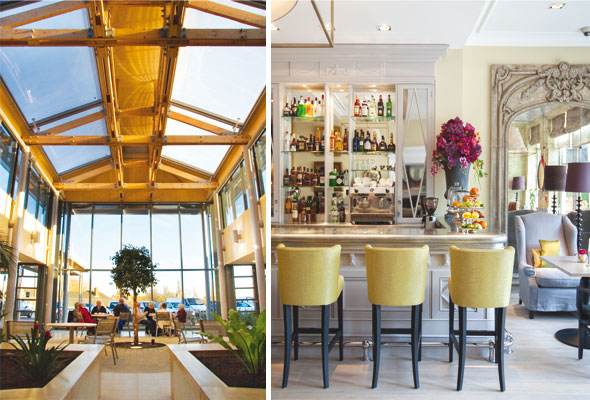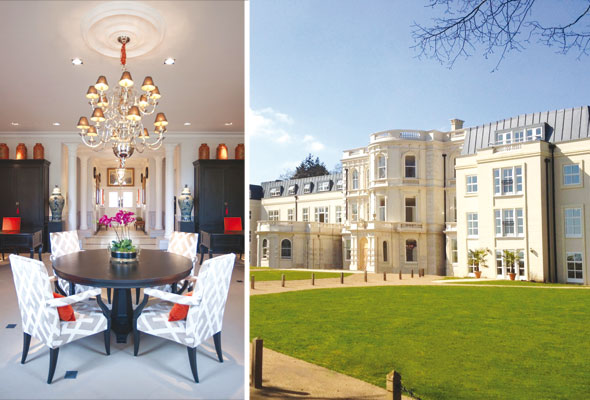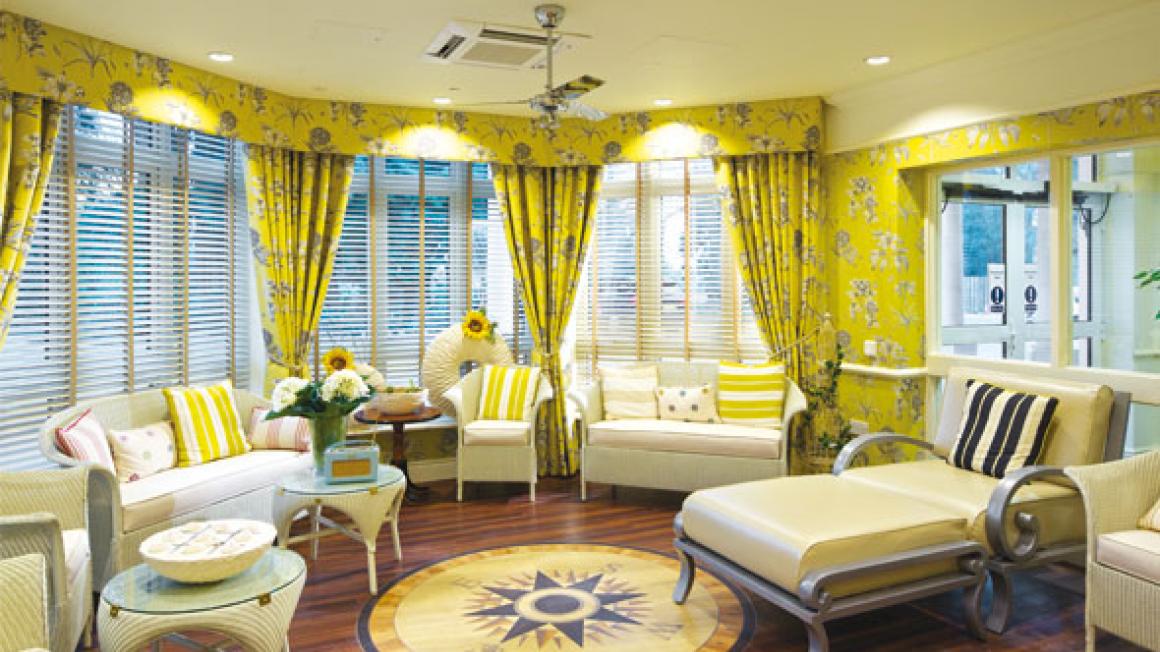THE CHOICE IS YOURS
RETIREMENT VILLAGES
These misconceptions have been faced by the builders of retirement villages, which are already a popular model in the USA, South Africa, Australia and New Zealand. The UK has lagged behind, according to Nick Sanderson, chief executive of Audley. We were speaking at the launch in June of Audley’s glossy new retirement village, Inglewood in Berkshire, described by the opening ribboncutter, Lord Carnarvon, as being ‘like a five-star hotel’. ‘It is 30 years since I first opened such a facility,’ he said, ‘and I thought then the market would change within 10 years.’
Both finance and public perception continue to be the two biggest problems. The financial crisis has made it hard to raise investment in a new concept so the number of retirement villages remains limited. ‘Also,’ says Sanderson, ‘prospective buyers will decide to buy in a development like Inglewood but their friends will then throw cold water on the idea by equating retirement property with care homes.’
Nothing could be further from the truth at Inglewood, built within a former stately home, with a magnificent lime avenue, and views over the Berkshire countryside from several first-floor flats. The restaurant and bar are open to the general public, so this is no gated, separate community, and the apartments are meticulously designed and equipped.
Those who would rather be in town could look at Urban Renaissance Villages’ latest purpose-built development, Millbrook Village in central Exeter. Luxury two and three-bedroom cottages and apartments surround a clubhouse, restaurant, bar, pool, fitness and health suite, library and medical centre. It’s open to anyone over 55, so is ideal for early retirees who want to be able just to lock up and go.
RESIDENTIAL SCHEMES
Most new retirement developments have generously sized rooms, enabling people to take large pieces of furniture with them. Churchill Retirement Living is introducing a wellbeing suite, with hairdresser, massage and chiropody, in its newest developments. ‘There’s still a misconception about what independent retirement living means,’ says a company representative. ‘We’ve been inviting people who have expressed an interest in us to special events, so they can meet residents and assess the lifestyle.’ More than 40 years old, Anchor opened its first sheltered-housing schemes in the early 1970s. In the 1980s, the organisation began to supply home-care services and establish care homes, and, in 2004, launched its first retirement village at Denham Green. Another two are under construction, although the main thrust of its operation continues to be smaller developments. A mix of rental and leasehold apartments is on offer, with 23,000 people currently in the former and 8,000 in the latter. Chief executive Jane Ashcroft says that the oldest resident living independently is a lady aged 107.
 Anchor's retirement village at Denham Green Right: The bar and bistro at Inglewood
Anchor's retirement village at Denham Green Right: The bar and bistro at InglewoodRESIDENTIAL CARE
Anchor is also a leader in care homes. As Ashcroft welcomes greater openness, Anchor took part in the National Care Home Open Day this June. ‘We need to be transparent. Many of our homes and developments are a community facility. They help where there are publicservice cuts by running social clubs, day care and libraries for older people. Opening up homes to public scrutiny gives providers confidence, too.’
Ashcroft applauds the recent Cavendish Report and hopes to see its recommendations being taken up. Training is a vital part of Anchor’s work, with new staff completing a three-month programme, including two weeks of initial training off the job. Subjects covered include kindness, compassion, dignity, health and safety, communication, dealing with diversity and safeguarding.
Guy Geller of Sunrise uK also welcomes the Cavendish Report, although with a caveat. ‘A proper level of certification would be good for the sector as long as the responsibility isn’t taken entirely out of the hands of the providers and given to the government,’ he says. ‘That might bring the worst up, but could also bring the top down to the average. We’ve revamped our training, and recently launched specialist dementia training, which has had demonstrable benefits.’
Sunrise, 32 years old in America, has been in the UK for 15 years. Geller notices a distinct difference between US and UK perceptions of how care should be paid for. ‘Consumers expect more care in the uK because of the NHS. In the US, we built our business around people who expected to sell their houses in order to move into our communities.’ So Sunrise is at the top end of the market, with 98 per cent of residents paying privately. Costs are divided between the rental for the apartment (a choice of studio, one and two bedrooms) and a separate charge for care.
Signature operates a similar model, with the rental covering lighting, heat, council tax, three meals a day and two daily wellbeing checks, with nursing care only paid for if needed. the Beeches is about to open at Brentwood in Essex, while four other communities are under construction.
Moorlands Lodge at Hindhead in Surrey opened 97 rental apartments in February 2012, with 20 specifically for dementia patients. It has a restaurant presided over by a professional chef, and an impressive dementia unit. Ornamental boots, hats and coats act as prompts by the door to the secure garden, while boxes of fabrics, 1950s clothes and a retro-style gramophone (in fact, a CD player) help those suffering from memory loss to recall earlier days.
Similar prompts are used at Monkscroft, a new care centre in Cheltenham. It is one of 70 care homes and seven Extra Care Housing schemes run by the Orders of St John Care trust across gloucestershire, Oxfordshire, Wiltshire and Lincolnshire. It has a homely feel, surrounded by gardens with raised beds and a greenhouse, and with a shop, cinema and hairdresser. Most distinctive is the employment across the trust of three My Home Life Admiral Nurses, specialists trained by Dementia UK.
The nurses work with staff and relatives to devise the best care for people living with dementia. ‘We put the person first, rather than making them fit in with our care system,’ says Mary Horner, the trust’s head of care quality. ‘We consult their psychological and physical needs, and their wishes, too. It’s very hard to find yourself in a home having lost a partner, perhaps, and no longer with any apparent control over your life. It helps to have a resident’s life story so we can understand their holistic needs.’
The importance of Admiral Nurses, says Angie Williams, head Admiral Nurse for the trust, ‘is to give simple tools and skills to the staff to help them improve the lived experience of those they are supporting. And we’re available to provide extra guidance.’
 The smart entrance hall at Inglewood Right: Inglewood retirement village in Berkshire is a former stately home
The smart entrance hall at Inglewood Right: Inglewood retirement village in Berkshire is a former stately home KEEPING ACTIVE
A vital responsibility for any care home is ensuring that residents are interested and stimulated, while respecting individual wishes. ‘It’s about people continuing to live their own lives,’ says Mary Horner. ‘We want to give them back normal things and reflect in their care plans what they have done before.’
That is also the aim of Sanctuary Care, with 59 homes across England, all of which can care for people with dementia. (It also has 27 extra-care schemes and 12 home-care branches providing support in people’s homes.) Each residential home has a dedicated activity leader to organise events such as arts and crafts, gardening, and entertainments, as well as working with residents one-to-one. One elderly fireman, for instance, was taken back to his former station to meet the crew and inspect their uniform and engine.
Some homes are beginning to introduce technology as a socially inclusive activity. Computers can offer creative stimulation, and help provoke reminiscence for residents with dementia, as demonstrated by Compaid. The charity is also working with Soundbeam and Skoog in Sunrise of Sevenoaks, Mount Ephraim House (Greensleeves) and the Tunbridge Wells Care Centre (Canford Healthcare), among others. Using invisible beams and tactile options, these technologies encourage gentle physical movement to interrupt a beam or touch surfaces lightly, resulting in instrumental, techno and environmental sound that creates expressive music. ‘Residents enjoy the Soundbeam sessions,’ says a carecentre representative. ‘Through it, they can express themselves in a carefully managed and sympathetically handled way.’
DOMICILIARY CARE
For the many who prefer to remain in their own homes, there is also considerable choice, with more than 3,000 domiciliary care companies in the UK. Many are local and small, but there are also some bigger players. Established in 1959, Country Cousins is an introductory agency that recruits carers, carries out DBS checks and takes up personal references, but does not actually act as employer. Others, like the Good Care Group and Bluebird Care, employ and train all their carers themselves.
All have found that needs are changing. ‘In the past, people wanted housekeeping and companionship,’ says a Country Cousins representative. ‘But because of the tough financial situation, families are handling that. Now our clients want personal care, so we look for carers w ith a minimum of six months’ experience.’
Live-in care, depending on the level required, costs from about £700 per week, and is therefore not necessarily cheaper than residential care once you’ve factored in the cost of running a house, and food for both carer and client. But, for some, the expense is secondary to the importance of staying in a much-loved house, surrounded by familiar things. Which is to come full circle – the joy of a retirement village is that you can have your own home, but arrange care when you need it. It’s your choice.


